Chapter 8
Reconcile Your Time and To-Dos
Create Your Weekly Plan
Seen and Heard
“I schedule long chunks of time to do work both on the weekends and evenings but am not always working efficiently the entire time.”
“I know what I have to do, but I'm not strategic (or disciplined) about when I'm going to do it.”
“The thirty-minute chunks in-between meetings or observations always feel like the biggest wastes of time because I don't know how to productively use them and never get anything real or meaningful accomplished.”
Overview and Objectives
Now that you've created your Comprehensive Calendar and Later List, it's time to craft a very detailed plan for your week ahead. So far, you've imprinted your big priorities, deadlines, and events into one single digital calendar. And you have sorted your To-Dos for the long term into an organized Later List.
Now it's time to zoom in. In my travels, I see leaders typically fall into one of a few camps when they get ready for the week ahead:
- Leaders who have a strong understanding of their calendars for the week, their meetings, and their events, but they do not have a clear plan on what to do with the open space between scheduled items.
- Leaders who start the week with a strong list, maybe even categorized, but they have little sense of whether they have time to accomplish items on the list—and no regard for physical location and energy levels.
Both of those methods are okay, but neither is strong enough to stand alone. We have to sew up your time and your To-Dos into one singular location for the week ahead, thus creating your Weekly or Daily Worksheet (see figure 8.1).
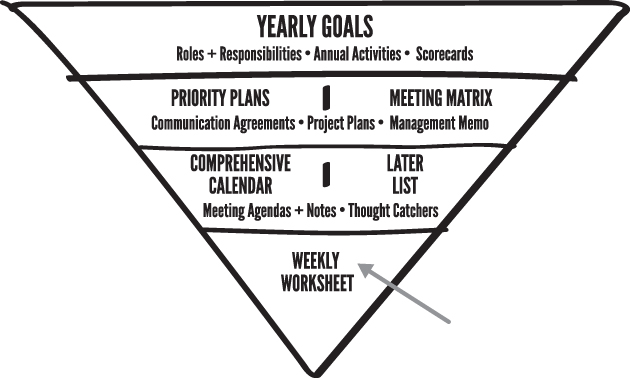
Figure 8.1 The Togetherness Tools
In this chapter, you will do the following:
- Master the how and why of getting micro for the week.
- Understand if you are time or task oriented and what that means for how you plan your week.
- Develop ways to get more time back in your day.
- Determine how to put it all together when you are on the move.
Before we engage with the actual tool, let's discuss the process of building it. The next section outlines reasons for how and why to prepare for your week.
The Model
Remember how you have been holding all of those Time Blocks in your Comprehensive Calendar? The ones for Planned Priorities and Standard Stuff? We are now about to break them down. Simply said, I am going to help you specify and break down your work into small little chunks. The point is not to be obsessive and overprogrammed but rather to ensure your work actually fits within a given day or week.
Similar to your other tools, your Weekly Worksheet can take a few different forms. Whichever one you choose, each model forces you to reconcile your time commitments with your To-Do List—and to fit the right work in at the right times. Here's a brief overview of three of the most common forms of Weekly and Daily Worksheets. Then we'll see a few real-life samples in action.
- Option 1. You might create a homemade list for the week, using one of my templates or making your own. This will work for those of you who are mostly nondigital. You can find many variations of the worksheet in figure 8.2 and the resource section of my website (www.thetogethergroup.com).
- Option 2. The next option is to use a template similar to the one shown in figure 8.2 but insert your digital calendar right into it. We will see an example of this in the coming section.
- Option 3. Instead of writing up a week on one page, you might choose to create five daily pages, often using your digital tools as a starting point. Figure 8.3 shows examples of a Daily Worksheet printed in Outlook and Google's Daily View. The handwriting captures unplanned items that popped up throughout the day.
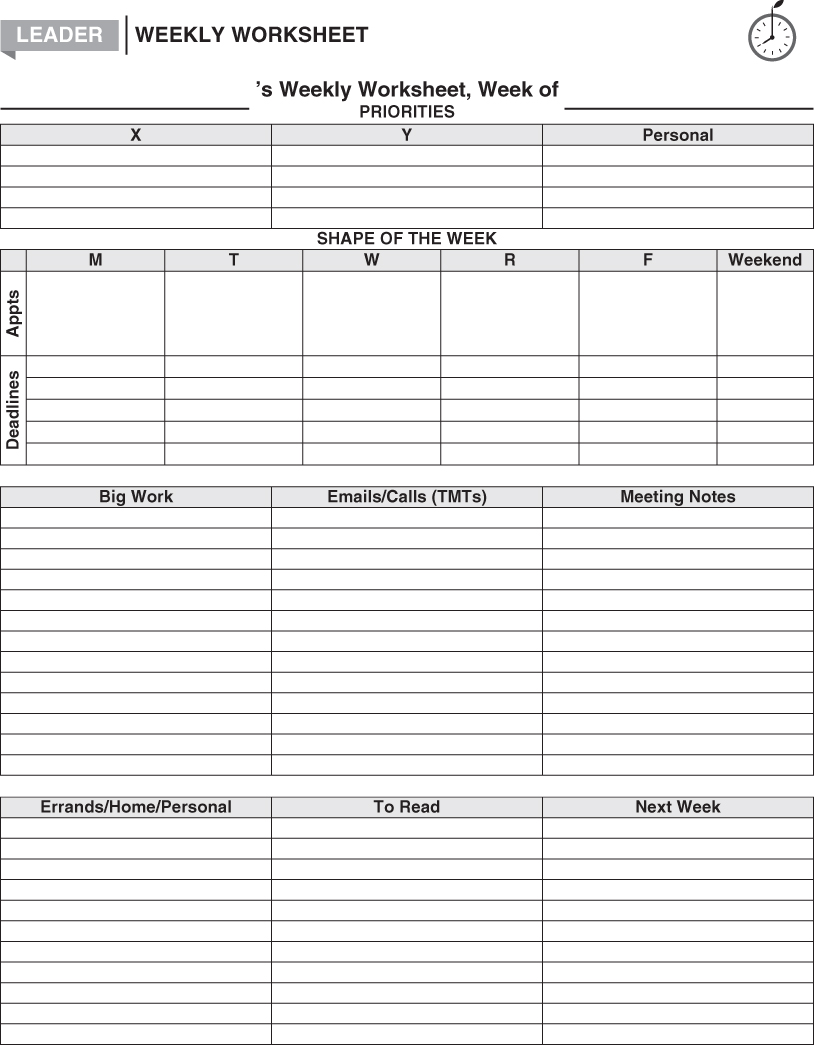
Figure 8.2 Weekly Worksheet Template

Figure 8.3 Daily Worksheets in Outlook and Google
Whatever tool you select, any good Weekly Worksheet will contain the following:
- Priorities clearly named (don't skip this!). This should flow through from your Priority Plan.
- All meetings and appointments listed, as well as Time Blocks mapped out for Standard Stuff
- All To-Dos spelled out by conducting a sweep of the Priority Plan, Later List, and your in-box
- Enough flexibility to handle the ambush of the week and your ever-changing environment
Task-Driven, Time-Driven, or Blended?
As you contemplate the best tool to map out your week, it is first helpful to know if you are driven by tasks (To-Do Lists are your friend) or time (you love your calendar). Let's take a short, unscientific quiz to determine where you land.
For those of you who raised your hand for option A, you are more driven by completion of the task, no matter how much time it takes. You probably love lists and start the week with a good one. It's likely that you are decently flexible. You may hate to start something because you fear being interrupted, so why bother? The challenge is that you may not have a clear understanding of the actual time you have to complete the items on your list. This may lead to overcommitment, procrastination, or both!
If you fell in the option B camp, you are a blended version. This is me. If a task will take me longer than an hour, I will automatically enter it in my calendar. The reason is that if you asked me to do something that would take an hour this week, I cannot magically squeeze it in. However, I don't want to enter everything in my calendar. That feels too constraining.
Option C means you are likely time driven. You probably start each week with a clear sense of your calendar commitments, but no plan for what to do with the white spaces in your days. You get nervous when you see loose To-Dos, and you likely feel comfortable when everything can fit in a week.
One way is no more effective than the other. I know that I prefer to be time-driven during the week, but task-driven on the weekend. The power is in knowing your preference, and using this knowledge to wisely blend your time with your To-Dos on your Weekly or Daily Worksheet. Now that you know your natural inclinations, let's examine several models of different ways effective leaders organize their weeks.
Now let's make it real. In the next section, we will meet several leaders who plan their weeks in very different ways, but they each do so at a high level of detail using a Weekly Worksheet.
Option B: Lo's Blended Time and Task Weekly Worksheet
Lo Nigrosh is an instructional coach for a Boston-based nonprofit, the Achievement Network. She moves around between schools all day. She is a heavy Google user, but doesn't want to slot every single To-Do in her calendar. She's slightly more motivated by a To-Do List than a calendar. But she does some very creative things to reconcile her time and To-Dos—and have them all with her in one place for when she's on the move (see figure 8.6).
I want to give a huge shout-out here to one of the original time management gurus, the late Steven Covey. Two concepts he made part of the regular vocabulary are
- 1. Big Rocks—Important activities, aligned to one's priorities, that have an outcome leading to the achievement of one's goals
- 2. Quadrant 2 Time—All activities can be classified by their urgency and their importance. Quadrant 2 time is focused on activities that are important, but not urgent, such as planning, prevention, and capability improvement.
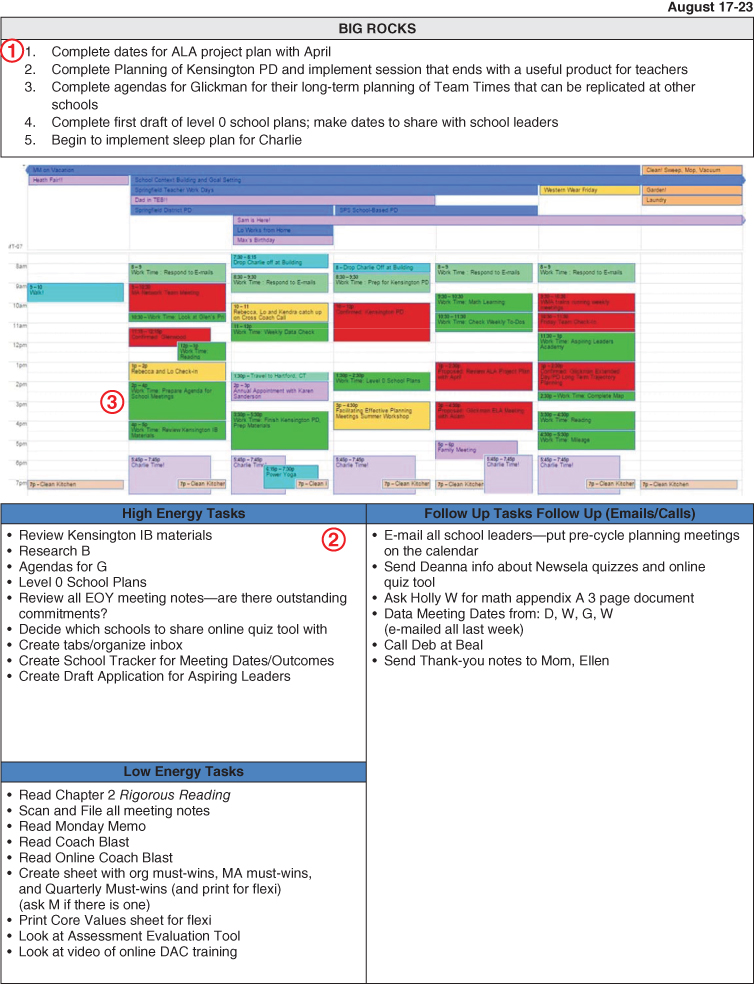
Figure 8.6 Lo's Weekly Worksheet: Before
This is one of my favorite examples for a number of reasons:
- 1. Lo writes out her priorities (big rocks) for the week. Lo uses her Priority Plan to determine her biggest priorities for the week. I also like how she includes the personal and professional.
- 2. Lo lists all of her To-Dos for the week. She gathers them up from multiple locations, such as her Later List, her in-box, meeting notes she has gathered, and so on. And then get this . . . she groups her To-Dos by energy level. The bigger brain jobs, such as “Review Kensington IB Materials,” are called high-energy tasks, and her low-energy tasks, such as printing a document, are tracked separately. This is a pretty awesome way to think about your To-Dos for the week. That way when you have an energy plummet, you can work the low-energy list.
- 3. Lo figures out how it will all fit into the time she has available. Lo opens her Google Calendar for the week and starts to fill out all of those macro work blocks she has been holding on to. If you look at Monday from 2 pm to 5 pm, she has a big block of time for that higher energy work. Lo populates most, but not all, of her major work blocks.
Because she is highly mobile throughout the week, Lo prints her Weekly Worksheet and uses it as a flexible guide—not a rigid script—for her time.
FAQ: What if something changes in Lo's schedule?
Things change all the time! In fact, let's look at exactly how much. Figure 8.7 shows Lo's Weekly Worksheet at the end of a week!

Figure 8.7 Lo's Weekly Worksheet: After
This is a messy, real-deal example here. Good organization tools should be messy because that means they are well used and well loved! Lo does this in a few different ways as she goes about her week:
- She takes meeting notes directly into her Weekly Worksheet. No more notebook full of hidden To-Dos and next steps! One less place to look.
- She fills in changes to her calendar as they happen.
- She enters her To-Dos into her open Time Blocks.
- She is also anticipating her weekend, planning for things such as “farmer's market” and “zumba or yoga.”
So, there you have it . . . Lo's half-paper, half-digital approach.
Reader Reflection
 What are the benefits of a more blended time and task approach?
What are the benefits of a more blended time and task approach?
Option C: Roslyn's Hybrid Time and To-Do Daily Worksheet
Meet Roslyn, a school leader. Similar to Lo, she's a Google-based person, but different from Lo, Roslyn gets ready for her week using another tool—Daily Worksheets, similar to the models you viewed earlier in this chapter. She still accomplishes the same outcome—an hour-by-hour plan for her time and To-Dos for the week ahead—but does so by planning each individual day, rather than the overall week.
Roslyn prints her already existing Comprehensive Calendar on Google, and then plans more specific tasks within the appointment space (figure 8.8). Because she's printed it in the daily view, it's highly portable and accessible for Roslyn as she moves around her school building.
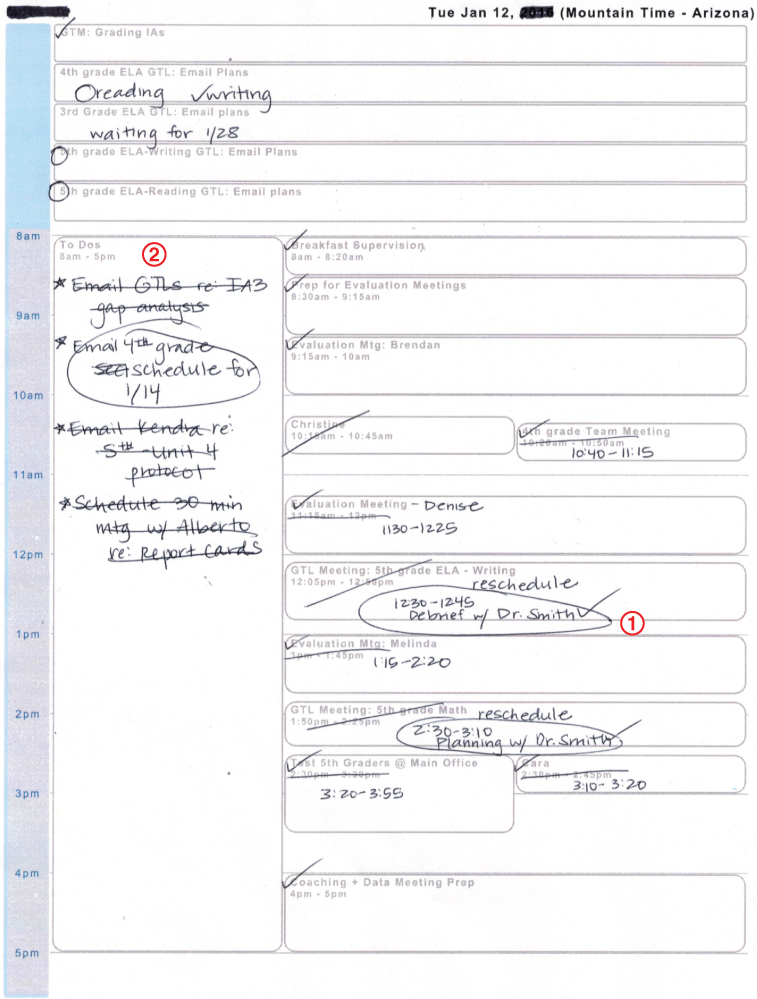
Figure 8.8 Roslyn's Daily Worksheet
Take a closer look at Roslyn's Daily Worksheet:
- Adjustments for changes—A grade-level meeting (GLM) was canceled and replaced quickly by “debrief w/ Dr. Smith.”
- Room to capture—Roslyn did something nifty here. Check out the left-hand side of her Daily Worksheet. She created an appointment called “To-Do” from 8–5. This gives Roslyn a To-Do box where she can capture items as they come up during the day. (Outlook users: this to-do box prints automatically for you.)
FAQ: Do I need both a Weekly Worksheet and Daily Worksheets?
 A resounding no. Even if you elect to print just the daily view, I still want you to plan for an entire week at one time. Both push you to do the exact same thing—develop a specific point of view about how you want to spend your week. Those who select the daily route just need to have five pieces of paper but are still planning according to the same principles—the tool just looks different.
A resounding no. Even if you elect to print just the daily view, I still want you to plan for an entire week at one time. Both push you to do the exact same thing—develop a specific point of view about how you want to spend your week. Those who select the daily route just need to have five pieces of paper but are still planning according to the same principles—the tool just looks different.
Option D: Mark's Digital, Time-Driven Weekly Worksheet
Mark DiBella is the superintendent of YES Prep Public Schools in Houston, Texas. At home, he's strongly committed to spending time with his family, running, attending church, and watching football. Mark does not have any loose tasks in his week; everything is programmed into a time slot (see figure 8.9). Those of you who are more task-driven like Dave or Lo may feel suffocated by this approach, and others might find the structure supportive. Either way is okay—this is an individual journey!
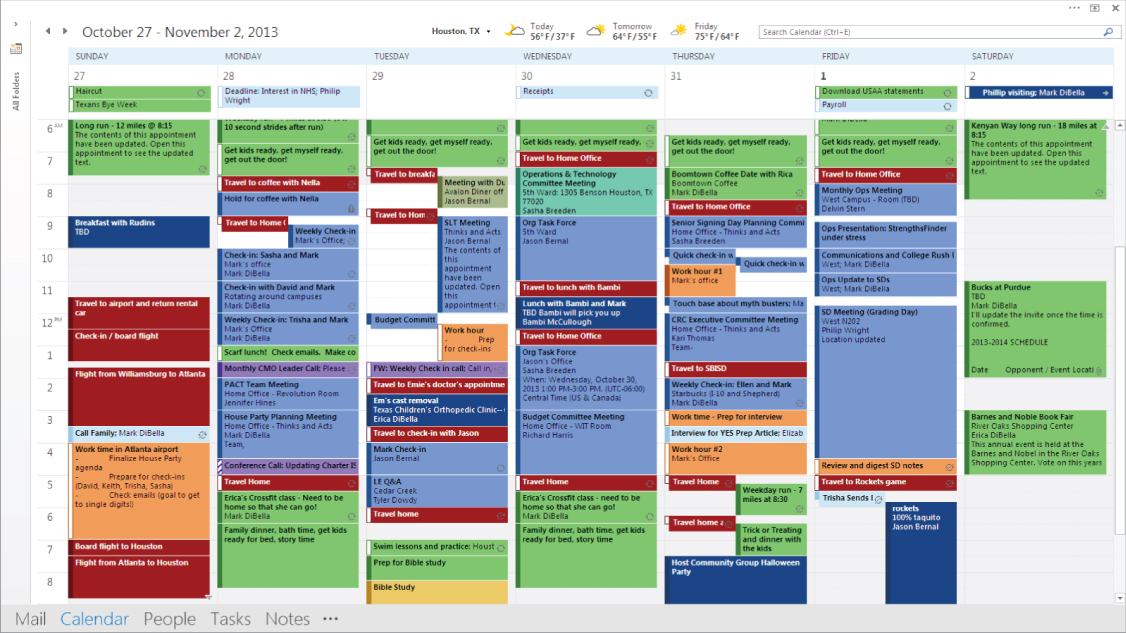
Figure 8.9 Mark's Weekly Worksheet
Mark's plan meets Weekly Worksheet criteria in a few ways:
- 1. Strategic color-coding. On my website (www.thetogethergroup.com), you can see how Mark smartly uses colors to scan his calendar to ensure it reflects his priorities. His personal and family commitments are in green, meetings are in blue, travel time is in red, and work time in orange.
- 2. Work block specificity. Similar to most Together Leaders, Mark doesn't wait for work time to magically present itself, nor does he go digging around for hours in his calendar with short notice. Instead, he uses his Later List (kept on paper in his notebook) to populate his prescheduled work blocks with specific tasks for the week. Bonus tech points here: Mark views his Outlook Calendar in appointment preview mode, enabling him to see right away what he's planned for each work block.
- 3. Personal and professional. Talking with his wife, Mark has carefully planned his free time in advance of each week. This enables them both to fit in exercise as well as quality time with each other and their two kids.
Within each appointment, Mark literally types in how he plans to spend that time. Lots of leaders do this. Figure 8.10 shows an example from Molly Day, a leader at the nonprofit organization LIFT, who spells out how she'll use the time on an upcoming train ride.
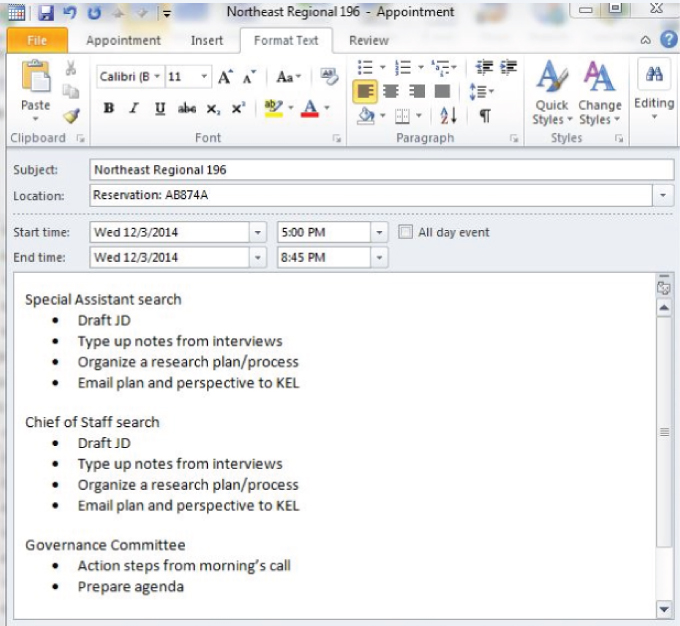
Figure 8.10 Molly's Train Ride Tasks
Now that you've seen four different models (and there are many more on my website, www.thetogethergroup.com), I want you to plan what will work for you. You'll want to carefully consider your own working style as well as the demands of your specific environment. You are free to choose or create whichever version of a Weekly Worksheet you wish—as long as you reconcile your time and To-Dos before the week actually starts.
Reader Reflection
 What elements of the Weekly Worksheet speak to you?
What elements of the Weekly Worksheet speak to you?
Build Your Own
I know you are excited to get started. Let's build your own Weekly Worksheet taking what appealed to you in the various models as well as what works best with your own preferences and work environment.
| If you are . . . | Select this Tool |
| Prone to procrastination | Select a time-based Weekly Worksheet model, such as Mark's or Roslyn's example. |
| Occasionally overcommitted | Select a time-based Weekly Worksheet model, such as Mark's or Roslyn's example. |
| In an organization that shuns technology in meetings and in hallways | Select a digital version, but print it or create a paper-based model such as Dave's. |
| A self-proclaimed Luddite | Select a paper-based model or even use an old fashioned commercial planner |
| Full of endless meetings that don't connect to priorities | Select a task-based model, such as Dave's, so at least your open space will be aligned to priorities. |
Once you select the format that works best for you, it's a matter of completing your Weekly Worksheet before the week begins. Let's walk through your steps to get it ready for the week (figure 8.11)!
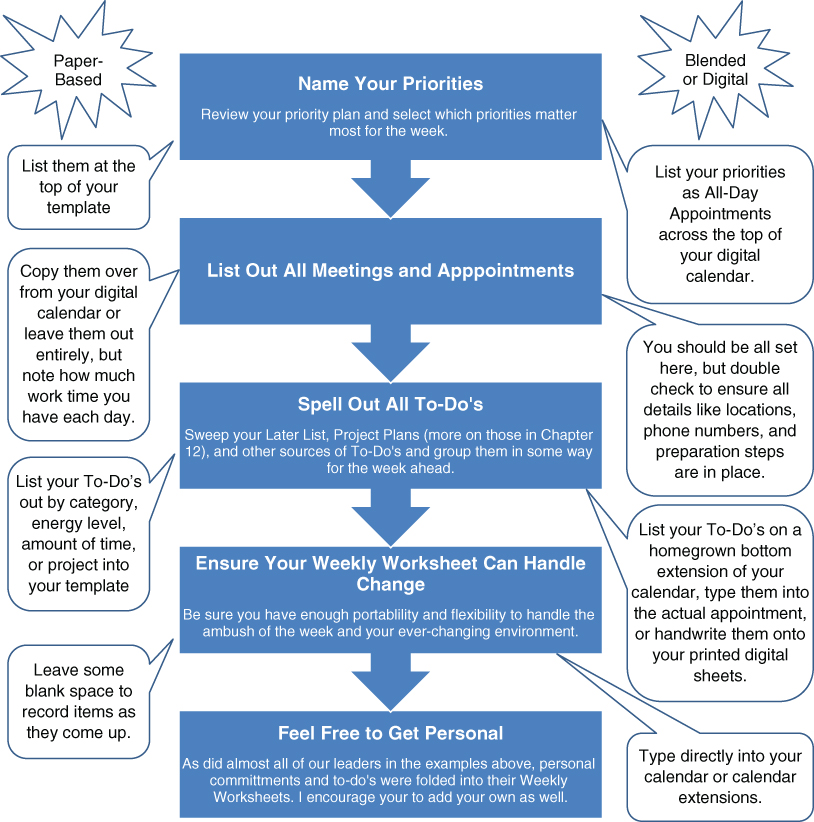
Figure 8.11 Build Your Own Weekly Worksheet
After you complete these steps (and there will be even more steps you can add in Chapter 9), your Weekly Worksheet is done and ready for the week ahead. But let's add a few more things to ensure you can make the most of your time ahead.
Reader Reflection
 How did it feel to create your Weekly Worksheet? What did you catch for the week ahead?
How did it feel to create your Weekly Worksheet? What did you catch for the week ahead?
Little Things Make a Difference
Now that your Weekly Worksheet design is locked down, let's think about some little things that will be helpful to include when you plan your week in more detail.
Time to Eat
This may sound silly, but one of the first things I do when I coach leaders is stock their offices with healthy snacks! I know you're not going out for luxurious lunches (unless you are wooing a funder), but you do have to eat. Whether you order lunch in or bring it from home, you need time to refuel. Even fifteen minutes of silence at your desk can go a long way to boost your endurance on a long day. And if you are prone to not eating because of lack of readily available options, keep food stashes everywhere. I have Ziploc bags in my purse, backpack, and suitcase that always contain something:
- KIND or Larabars
- Nuts
- Dried fruit
- Organic, no-sugar beef or turkey jerky
- Fresh fruit or veggies
- Water bottles
I often preorder huge amounts of healthy snacks from Amazon or stock up at Costco, so I can just grab something and run out the door. You may consider doing what Tom Rath, author of Eat, Move, Sleep and Are You Fully Charged?, and others advise, which is to “standardize” your lunch each day so you don't even have to think about it.
Time to Move
Yes, yes, yes, this is a professional book. However, the benefits of physical movement are so great, that I would be remiss if I didn't mention blocking out time to exercise. Whenever I ask mission-driven leaders what they wish they had more time for, exercise always tops the list.
And Tom goes on to quote the University of Illinois's Justin Rhodes (2013), “Research shows that when we exercise, blood pressure and blood flow increase everywhere in the body, including the brain. More blood means more energy and oxygen, which makes our brain perform better.” Convinced? I got convinced. Looking at your week to find time to move could be done in these ways:
- Reviewing the gym schedule and picking two to three classes that fit in your week (bonus points if you have already entered all relevant classes in to your Comprehensive Calendar!)
- Getting a fitness tracker, such as FitBit or JawBone , to track your steps; most people like to hit ten thousand per day
- Shifting various parts of your commute so you walk part or all of the way
- Getting a standing working desk
- Taking some of your meetings while walking outside
Reader Reflection
 Review your Weekly Worksheet for next week. When will you recharge with food and exercise?
Review your Weekly Worksheet for next week. When will you recharge with food and exercise?
Time to Travel
Many a leader race from building to building, frantically looking for parking or climbing the stairs two at a time. If you move around frequently, be sure to add these buffers in your calendar for travel:
- Your regular commute to and from work
- Traveling between meeting locations
- Traveling to and from the airport or train station (more on travel in Chapter 9)
If you zoom in on Mark's Weekly Worksheet, you see he blocked time for travel to and from his coffee meeting (figure 8.12).
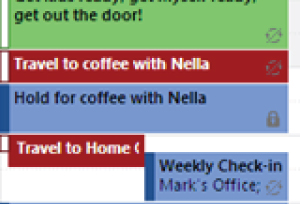
Figure 8.12 Mark's Calendared Travel Time
Reader Reflection
 Look ahead for one month on your Comprehensive Calendar. When will you need to block travel time?
Look ahead for one month on your Comprehensive Calendar. When will you need to block travel time?
Although perhaps none of these calendar tricks is rocket science, I do find most leaders I meet say “I don't have time to exercise,” or “I'm constantly running behind,” or “I just frittered away fifteen minutes on social media.” I'm not asking you to be a robot here but rather to make room for things such as eating, sleeping, and exercising that will help you feel and be more Together. If we don't schedule them into our calendars, they are less likely to happen.
Some Other Sneaky Calendar Tricks
Similar to these samples, your Weekly Worksheet should look about 80 to 90 percent full. Depending on how many emergencies tend to arise, you can determine how much time should be unscheduled. Just make sure you also have a plan for what to do if an emergency doesn't fill all of the time.
You can also start moving things around to maximize your time even more. In the next section, you will find a consolidated list of tips to make the most of your energy, small pieces of times, and chunks of work.
Managing Energy
I am a huge fan of Tony Schwartz's work at The Energy Project. Once your work is all laid out for the week, you make changes based on your energy levels, mental bandwidth, or brainpower at certain times of day. For example, if you know your energy typically dips around 3 pm, you could reserve this time for signing checks, approving time sheets, or accomplishing the other less mentally taxing things on your list. Or, if you're a morning person who works best without distractions, you might reserve two to three early mornings a week to dive into deeper projects, such as writing memos, creating agendas, or drafting performance evaluations.
Reader Reflection
 Review the week ahead. What can you adjust to help you manage your energy?
Review the week ahead. What can you adjust to help you manage your energy?
Managing Organizational Rhythms
The classic case here is the chronic use of Mondays for meetings. All that does is drain everyone of his or her energy at the start of the week and make people dread coming to work. Move internal meetings to the end of the week when everyone needs a nice pick-me-up and can look ahead to the following week. Thursday afternoon and Friday mornings can be great times to have standing internal one-on-one meetings. Leave Mondays for big, important thinking work.
Reader Reflection
 Consider the rhythm of your week. What tasks and meetings do or do not need to happen on particular days of the week?
Consider the rhythm of your week. What tasks and meetings do or do not need to happen on particular days of the week?
Batch Process
Too many of us do lots of little things all day long. Why not put them all together? For example, if you sign checks, let people know which day and time you'll do this each week and leave them a clear directive on where to put the checks. Then, sign them all at once. You can apply this concept to cooking, answering e-mail, and sending contracts, too. Batch processing can also help if you tend to avoid some boring administrative tasks. And per previous comments on personal health, maybe you can grocery shop or cook all at one time, too. If only exercise worked like that … Gretchen Rubin's recent book, Better Than Before, recommended saving an hour per week, called Power Hour, for all of the little annoyances that can linger on a list, such as “fix office chair.”
I've recently instituted a “twenty small things to do on Sunday Nights” chunk of time in my calendar. Whenever I generate or acquire a small task during the week, I often dump it into my calendar for Sunday evening. I know I need to get a little work done, but after spending the weekend with my lovely small children, I'm too exhausted to give my attention to anything that requires any degree of thoughtfulness. Tasks such as paying parking tickets, scanning receipts, booking flights, and inputting data land here.
Reader Reflection
 What small tasks can you batch process for efficiency? What would you need to communicate to your team to make this system effective?
What small tasks can you batch process for efficiency? What would you need to communicate to your team to make this system effective?
Using Small Pockets of Time
Be prepared to use those little pockets of time that arise when someone is late to a meeting, your flight is delayed, or you arrive somewhere early. A few tricks I rely on:
- Keep a plastic envelope of thank-you notes and stamps at the ready.
- Carry a folder of articles you may want to read.
- Have a few interesting podcasts preloaded on your smartphone.
- List topics that need brainstorming in a small notebook.
- Keep your To-Do List organized by how much time something will take you, and check off the little things when you can.
Jason Womack details many more options in his book Your Best Just Got Better.
Reader Reflection
 What preparation do you need to fully use your small pockets of time?
What preparation do you need to fully use your small pockets of time?
Strategic Multitasking
I'm not talking about the kind of multitasking that involves checking out of a conference call to answer your e-mail. I'm talking about smartly combining activities that meet your goals. As you look at the full view of your week, you may find opportunities to combine some items to accomplish your priorities. For example, you want to foster strong relationships with your team and you clearly need to eat. Can you set aside one meal per week to share with a staff member? Or maybe people often request your career advice, but you still have to make your kids' lunches or wash dishes at night. When I get asked for conversations that just require me to listen deeply but not take notes, I frequently offer time slots when I may be doing other low-level work—and I disclose this to the other person in advance so they don't feel slighted.
Reader Reflection
 Review next week's priorities and appointments. Are there opportunities for strategic multitasking?
Review next week's priorities and appointments. Are there opportunities for strategic multitasking?
Now that your Weekly Worksheet is strategically aligned to your energy levels, thoughtfully arranged with organizational rhythms, coordinated for batch processing, and full of a few bits of strategic multitasking, let's get real about all of the things that get in the way of that beautifully constructed week.
But, Maia, What about Things That Just Come Up?
Now that you have your calendar entirely set, let's consider how to protect it. Or, as I say in workshops, “Let's move from ideal to real.” On any given day, any number of situations can squash our best-laid plans. Some of these “situations” are actually things we do to ourselves, and other times the crushers come from our colleagues, our external landscape, or even our own children!
Internal Crushers
There are just so many crushers we bring on ourselves. I'm no psychologist, but I've seen people fall completely prey to any of the number of situations described in the following, including myself. Some of them will sound familiar. Maybe you've set aside time to work, but then you avoid what you'd planned to work on? Or maybe you woke up early to write a book chapter (ahem) but then just cleaned out your in-box instead? Or maybe you meant to focus on that grant report, but trolled over to Huffington Post?
Table 8.2 shows a list of common internal crushers and some possible solutions.
Table 8.2 Common Internal Time Crushers
| Common Internal Crushers | Description | Possible Solutions |
| Lure of the lusty checkmark | You're completely addicted to getting things done but perhaps fall prey to easy wins at the expense of bigger priorities. |
|
| Procrastination | Enough said. |
|
| Distraction | If you find yourself with ten windows open on your computer and spend a lot of time on social media, this could be you! |
|
| Perfectionism | If you find yourself spending an excessive amount of time color-coding or formatting documents, you are guilty as charged. |
|
| Rapid responder syndrome | You feel compelled to reply to every e-mail, message, or text as soon as it comes in, thus killing your ability to focus. |
|
Reader Reflection
 Which internal priority crushers do you face? What solutions are you committed to trying?
Which internal priority crushers do you face? What solutions are you committed to trying?
External Crushers
Of course there are also a whole host of external factors (table 8.3), many of which we have little control over. But we can manage some of them better than we do.
Table 8.3 Common External Time Crushers
| Common External Crushers | Description | Possible Solutions |
| The ambush, pop-in, or fly-by | Someone or something pops up at your cubicle, turkey necks by your office, or prairie dogs by your desk! |
|
| The good idea fairy | This could be you or someone else. Either way, a “good idea” comes up, and you or your team feels compelled to chase it down. |
|
| Ambiguity | The path forward is unclear or people have various levels of commitment to the priority. |
|
| Staff drama | Other people's issues |
|
| Other people's poor planning | This one is fairly self-evident: when you're the victim (or perpetrator) of a last-minute and urgent request |
|
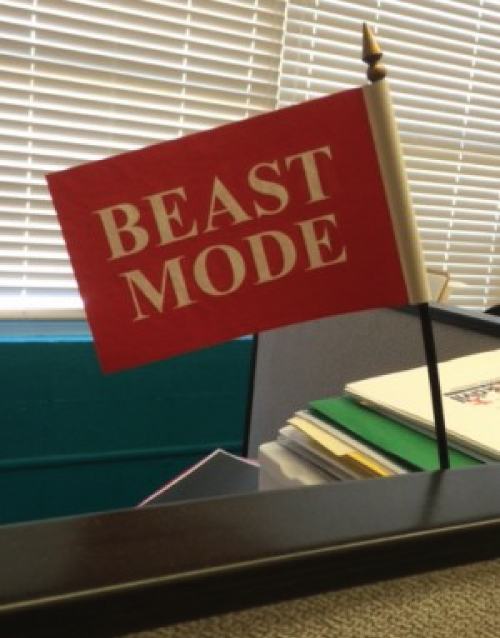
Figure 8.13 Beast Mode Flag
Both sets of solutions are rooted in three themes:
- 1. Systems building. Yes, it will take time up-front to build a system to prevent chronic interruptions, but it will save you so much in the long run!
- 2. Trust. It can feel hard to have a conversation with a colleague to sort out roles and responsibilities for an ambiguous project. But if you build trust with your team, they will know your intentions are good!
- 3. Communication. It will take some effort to sit with a team and map out how their workload affects you, but it will prevent a lot of last-minute asks and leave room to address proactive work and the real emergencies.
Reader Reflection
 Which external priority crushers do you face? What solutions are you committed to trying?
Which external priority crushers do you face? What solutions are you committed to trying?
Tracking the Crushers
If you're not sure what kinds of crises you may face in your role, use my Crusher Tracker (available on my website, www.thetogethergroup.com) to analyze what pulls you off task from your ideal schedule. With your team, revisit any patterns that emerge to see what you can proactively put in place to address the issue in the future. What was once a surprise becomes predictable and planned for.
If your entire team or organization is plagued by crushers, I recommend having everyone track them. Then categorize them using the Common Crushers buckets from table 8.2 and table 8.3. You can then facilitate strong, data-driven discussions about why the crushers exist and how you might solve them.
Table 8.4 shows us a Crusher Tracker from Hannah Lofthus, the CEO of the Ewing Marion Kauffman School in Kansas City.
Table 8.4 Hannah's Crusher Tracker
| Crusher | Time Spent on It | Took Away From |
| Personnel issue re: staff transition | 4 hrs | Weekend—personal |
| Hiring search | 2 hrs | Weekend—personal |
| Emergency at district | 20 min | Work time |
| Personnel issue | 30 min | Work time |
| Emergency personnel issue | 5 hrs (over 2 days) | Work time, quadrant 2 time, hiring search prep, doctors appointment |
| Bus issue | 1 hr | Evening—personal /e-mail |
| Check-ins | 2 hr | Prep, work time |
Thankfully, Hannah already had work and prep time blocked into her calendar, so there was room in her day to tackle the emergencies. But we also thought together about the following questions:
- 1. What could have been delegated? Although the bus issue could not have been totally delegated, Hannah realized she could have modeled, taught, and coached her team further so that this issue doesn't come immediately to her in the future.
- 2. What could have been predicted? The hiring search was entirely predictable work. Although they couldn't have predicted when the search firm would send candidates, Hannah and her assistant did know the process would consume a certain amount of hours. They can block time for these sorts of happenings in the future.
- 3. What could have been prevented? Although the personnel issue was not predictable, it was preventable. To address this moving forward, Hannah implemented office hours to hold strategic conversations with various teachers. This will help provide insight into any brewing issues ahead of time.
There are also the truly true emergencies that pop up. Some are exciting, such as earning a grant at the last minute, and others are tragic, such as a school district experiencing the death of a community member. These things will happen, but when you have a great plan and a reliable way of communicating it to others, they are much, much easier to deal with.
Reader Reflection
 What are the true, unanticipated emergencies you've experienced in the past six months? How did you and your team do at managing them? What could have been predicted or prevented?
What are the true, unanticipated emergencies you've experienced in the past six months? How did you and your team do at managing them? What could have been predicted or prevented?
Keep It Alive: The Routine
You are likely wondering the when and where of creating your Weekly Worksheet. I will go into great detail on this answer in the next chapter on routines. But the short answer is that I want you to take a small chunk of time, about sixty minutes, on Thursday or Friday, and devote it to planning for the following week.
I know an hour can feel like a lot, but it will be so worth it because you will go into each week with such a clear sense of what you want to accomplish and knowledge of how you will get it done. You will print it out, if necessary, or keep highly accessible on your devices. As the week goes on, you will likely prioritize by moving items around, and you will also record new To-Dos as they come flying at you. The key here is you have one single place where everything is going for the week.
And once you are finished with a Weekly Worksheet, you can simply transfer any undone To-Dos (and trust me, they will be there) into the appropriate spot and throw the old worksheets away. There is no need to keep them. If you feel nervous pitching them, take a photo or dump them in a box.
Start Strong
In this chapter, we looked at our own preferences for organizing a week, examined models from four different Together Leaders, and added in some time for exercise, eating, and sleep. Although planning a week at this level of detail may feel constraining, I firmly believe it can lead to more flexibility. When the emergency or opportunity arises, you will be completely aware of what you are sacrificing when you pivot to a pop-up. It is all about striking the right balance between systems and spontaneity!
Time commitment: Once you establish your template or tool, this process will likely take you about sixty minutes per week.
- Determine whether a task, time, or blended orientation works best for your working style, preferences, and environment.
- Select the right tool for your Weekly Worksheet. Are you going to make a task-driven model such as Dave's, a hybrid such as Lo's, daily pages such as Roslyn's, or go mega-digital such as Mark's?
- Use your Priority Plan and Later List to create your Weekly Worksheet for the coming week.
- Review your Weekly Worksheet to see if there are opportunities for batch processing, strategic multitasking, or using small pockets of time.
- Track your Time Crushers to see where you might be able to get some time back.
Common Challenge: Too Much to Do!

When I first started working with Max Koltuv, a regional superintendent at Achievement First, before he began regularly looking ahead and blocking off work time to address his priorities—which included providing direct school support and participating on a senior management team—we stared together, stumped, at the week of September 22.
“Whoa,” I said.
“See, I told you so,” he responded.
According to Outlook, it was indeed a very full week. Tuesday, Wednesday, and Thursday were entirely blocked for principal meetings, a school visit, and two days of an executive team retreat. That left Monday and Friday to get out in the field, take phone calls with the schools he couldn't get to, and prep for the big meetings mentioned previously. Oh, yeah, and what about walking his daughter to school three times, hitting the gym twice, observing the Jewish holidays, and attending an evening board meeting? Yep, that was all in there, too.
We were looking at a perfect storm of a week for Max, and even a ninja-like level of personal planning wouldn't have helped. Although I do want you to be able to evaluate each meeting and To-Do to ensure each one is absolutely connected to your goals, the items on his calendar were structural issues over which Max, no matter how senior he was, had very little control. Luckily, this week was a point-in-time situation, not the norm.
We brainstormed five steps to ease the pain of Max's very full week:
- 1. Chisel, chisel, chisel. Review every single meeting in your calendar and ask if it can be canceled, postponed, delegated to a colleague, or completed in half the time. It's not crazy to name your dilemma to others and ask for forgiveness. And then do this proactively moving ahead to ensure only priority meetings take a spot on your calendar.
- 2. Post an auto-responder. Even in today's connected world, people often forget to do this. Max created an out-of-office message that included details about his meeting schedule and let people know to expect a delay in reply. (There are a few examples of out-of-office replies in other chapters.)
- 3. Aggressively manage expectations of those around you. We drafted an e-mail to Max's assistant, team members, and managers to explain that Max was going under for the week. We asked that they please hold all nonurgent e-mails, draft subject lines carefully, and simply be aware of the crunch he was facing.
- 4. Have a plan for e-mail. Okay, it happens to all of us: you are in a workshop, conference, or retreat for a day, and the e-mails pile up. And yes, you have managed expectations as mentioned previously. But time-sensitive stuff is still going to come in! If you're constantly checking on your smartphone and then aimlessly rechecking again at night, you need a better method to avoid this double processing. Max blocked an appointment called “e-mail” each evening in his calendar and used this time to address anything that had to be answered that day. Other stuff was moved to later on his Calendar or his Later List.
- 5. Block time next week to unbury. The next week wasn't much better in Max's world, but we were able to proactively block off a couple of hours for him to completely unbury out of the storm. Max triaged his in-box for the messages he'd put on hold, checked in with his team to see if there were any other issues that emerged, and realigned with his assistant.
The trick here is to get ahead of these very full weeks by anticipating them in advance. You will be able to do this if you are in a committed relationship with your Comprehensive Calendar and regularly looking ahead!
